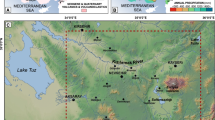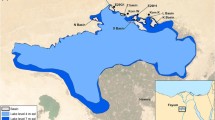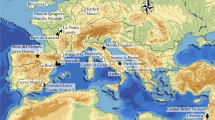Abstract
Over one hundred artifacts, including shards, chopped wood, bronze and iron ware debris as well as footprints, have been discovered during archaeological investigations at and around the central Taklamakan Desert Yuansha Site (38°52′N, 81°35′E). Dating (14C and OSL) and landform study show that the present-day dry Keriya River once sustained an oasis human settlement in 2.6 ka BP, historically falling into the Spring and Autumn Period (716–475 BCE) of Chinese history. The chronology and archaeological interpretations also show that some 400 years later, the local Keriya River channel had shifted 40 km southeast to sustain a Western Han (206 BCE-25 CE) Wumi settlement at the Karadun site. In the meantime, river-channel migration had allowed reoccupation of a site west of Yuansha City around 1.9 ka BP (abandoned again by 1.6 ka BP). The remains’ chronology shows that this site was affiliated to Wumi culture and Eastern Han (24–220 CE) dynasty rule. Palaeoclimatic records indicate that the migrations of the river and oasis settlers between 2.7 and 1.6 ka BP were coeval with Central Asian climate changes. Yuansha City was built just after the end of 2.8 ka BP glacier advances in western China, suggesting that release of more water during the subsequent glacier recession may have facilitated oasis development such that Iron Age European peoples could settle in the Tarim Basin. As shown from analysis of archeological remains, not only at Yuansha but also in other ancient cities in the Tarim such as Loulan and Jingjue (Niya), conditions around 1.6 ka BP were dry enough to cause oasis decline. Thus, the results reported here enhance our knowledge about environmental changes and their effects on human activities and cultural evolution in western China and will stimulate further interdisciplinary studies of landscape and oasis history in the Tarim Basin.
Similar content being viewed by others
References
Li J. The relation between the down of ancient Lou Lan Kingdom and the change of Silk Road and climate (in Chinese). In: Xinjiang University, Bureau of Geology and Mineral Resources of Xinjiang, Academy of Sciences, Xinjiang, eds. The Collected Papers on Recent Quaternary Researches at Xinjiang in the Arid Area of China. Urumqi: Xinjiang People’s Publishing Housing, 1985. 81–94
Huang W. Comments on the ancient Tarim River and its changes (in Chinese). In: Huang L, ed. The Collected Papers of Huang Wenbi on History and Archaeology. Beijing: Heritage Press, 1989. 43–51
Wang B. Several problems about historical geography in the southern road of ancient “Shi-Yu” (in Chinese). Geogr Res, 1983, 2: 30–43
Wang S. Textual research on the “South River” of Tarim Basin recorded by “Shui Jing Zhu” (in Chinese). Geogr Res, 1987, 6: 36–44
Fan Z. A study on the formation and evolution of oasis in Tarim Basin (in Chinese). Acta Geogr Sin, 1993, 48: 422–427
Xiong H, Zhong W, Tiyip T, et al. The coupling relationship between the nature and the man in south edge of Tarim Basin (in Chinese). Acta Geogr Sin, 2000, 55: 191–199
Han K. The Collected Papers About the Racial Anthropological Study of the Ancient Silk Road Inhabitants (in Chinese). Urumqi: Xinjiang People’s Publishing House, 1990. 1–32
Gao S, Cui Y, Yang Y, et al. Mitochondrial DNA analysis of human remains from the Yuansha Site in Xinjiang, China. Sci China Ser C-Life Sci, 2008, 51: 205–213
Lin M. A study on Tokharians’s origin and migration (in Chinese). W Region Res, 2003, (3): 9–23
Chen G, Zhang Y. Review and prospect of the archaeology in Xinjiang at the end of 20 century (in Chinese). W Region Res, 1999, (1): 1–11
Lu H, Xia X, Liu J, et al. A preliminary study of chronology for a newly-discovered ancient city and five archaeological sites in Lop Nor, China. Chin Sci Bull, 2010, 55: 63–71
The Institute of Archaeological, Xinjiang Academy of Social Science. The tomb on the Pamir Plateau (in Chinese). Acta Archaeol Sin, 1981, (2): 198–216
The Museum of Xinjiang Uygur Autonomous Region, Xinjiang Institute of Archaeology. The excavate report of the graveyard at Sampula Site (in Chinese). In: Xinjiang Institute of Archaeology, eds. New Achievements in Archaeological Research in Xinjiang During the Time Span (1979–1989). Urumqi: Xinjiang People’s Publishing House, 1995. 421–469
Yu Z. The excavate report of the graveyard 95MNIM8 at Niya Site in Xinjiang, and a preliminary study on it (in Chinese). W Region Res, 1997, (1): 1–10
Xinjiang Institute of Cultural Relics and Archaeology, the 315 Institute of French National Center for Scientific Research. Summaries of the archaeological investigation along the Keriya River in Xinjiang (in Chinese). Archiaeology, 1998, (12): 28–37
The Museum of Xinjiang Uygur Autonomous Region, CPAM of Bayingolin Mongolian Autonomous Prefecture, CPAM of Charchan County. Excavate of the Graveyard No. 1 at Zagunluk in Charchan, Xinjiang (in Chinese). Acta Archaeol Sin, 2003, (1): 89–136
Shui T. A report of the symposium of the prehistoric archaeology of Xinjiang (in Chinese). W Region Res, 2008, (4): 98–102
Yang X. The relationship between oases evolution and natural as well as human factors: evidences from the lower reaches of the Keriya River, Southern Xinjiang, China (in Chinese). Earth Sci Front (China Univ Geosci), 2001, 8: 83–89
Huang W. Records of Archaeological Investigations in the Tarim Basin (in Chinese). Beijing: Science Press, 1958. 49–51
Wu Z, Huang X. The Investigation of Karadun Ruins in the Lower Reaches of the Keriya River (in Chinese). In: Xinjiang Keriya River and the Taklamakan Desert Scientific Expedition Team, ed. The Report of Scientific Exploration and Investigation in the Keriya River Valley and the Taklamakan Desert. Beijing: China Science and Technology Publishing House, 1991. 98–116
Zhou X, Li B, Zhu F, et al. The research on the development and evolution of the oasis of Keriya River in the Tarim Basin of Xinjiang (in Chinese). Yunnan Geogr Environ Res, 1996, 8: 44–57
Yang X, Zhu Z, Jaekel D, et al. Late Quaternary palaeoenvironment change and landscape evolution along the Keriya River, Xinjiang, China: The relationship between high mountain glaciation and landscape evolution in foreland desert regions. Quat Inter, 2002, 97–98: 155–166
Zhu Z, Lu J, Jiang Z. Study on formation and development of aeolian landform and trend of environmental change at lower reach of the Keriya River, Taklimakan Desert (in Chinese). J Desert Res, 1988, 8: 1–10
Yuan Y, Li J. The wet-dry change in recent 40 years in Taklimakan Area (in Chinese). Arid Land Geogr, 1998, 21: 18–24
Yuan Y, He Q, Li J, et al. Temperature variation in the recent 40 years in Taklimakan area (in Chinese). J Desert Res, 1998, 18: 118–122
Tadono T, Shimada M, Murakami H. Calibration of PRISM and AVNIR-2 Onboard ALOS “Daichi”. IEEE Transact Geosci Remot Sens, 2009, 47: 4042–4050
Reimer PJ, Baillie MGL, Bard E. IntCal04 terrestrial radiocarbon age calibration, 0–26 cal kyr BP. Radiocarbon, 2004, 46: 1029–1058
Hou X. Chinese History Chronology Table (in Chinese). Urumqi: Xinjiang People’s Publishing House, 2002. 1–234
Backer V R, Pickup G, Polach H A. Desert palaeofloods in central Australia. Nature, 1983, 301: 502–504
Hu Z. A report of recent 14C dating result (1) (in Chinese). J Desert Res, 1989, 9: 72–75
Archaeology Group, Taklamakan Desert Scientific Expedition Team, Chinese Academy of Sciences. A brief report of the investigation at the Majianglek in Yutian County. In: Wang B, Du G, eds. New Achievements in Archaeological Research in Xinjiang During the Time Span (Continuation) (1990–1996) (in Chinese). Urumqi: Xinjiang Art Photography Publishing House, 1997. 490–495
Yin Q. The Wumi, a kingdom buried under the desert sands: A study on its location (in Chinese). Soc Sci Xinjiang, 1985, (1): 65–79
Chen G. Xinjiang pre-historic cultures (in Chinese). N W Ethno-Nati Res, 1995, (1): 40–50
Chen J. Preliminary research on the Mid-and Late-Holocene Glacial Fluctuations in Tianger Peak II regions, Tianshan Mountains (in Chinese). J Glacil Geocryol, 1987, 9: 347–356
Jiao K, Yao T, Li S. Evolution of glaciers and environment in the West (in Chinese). J Glacil Geocryol, 2000, 22: 250–256
Li Z, Shen Y, Wang F, et al. Response of glacier melting to climate change-Take Urumqi Glacier No.1 as an example (in Chinese). J Glacil Geocryol, 2007, 29: 333–342
Han T, Gao M, Ye B, et al. Characteristic of runoff process of the glacier and permaforst in the headwaters of the Urumqi River (in Chinese). J Glacil Geocryol, 2010, 32: 573–579
Chu K C. A preliminary study on the climatic fluctuations during the last 5000 years in China. Sci China Ser A, 1973, 16: 226–256
Xia X, Wang F. Lop Nur in China (in Chinese). Beijing: Science Press, 2007. 1–482
Yao T D, Thompson L G, Qin D H, et al. Variations in temperature and precipitation in the past 2000 a on the Xizang (Tibet) Plateau-Guliya ice core record. Sci China Ser D-Earth Sci, 1996, 39: 425–433
Author information
Authors and Affiliations
Corresponding author
Rights and permissions
About this article
Cite this article
Zhang, F., Wang, T., Yimit, H. et al. Hydrological changes and settlement migrations in the Keriya River delta in central Tarim Basin ca. 2.7–1.6 ka BP: Inferred from 14C and OSL chronology. Sci. China Earth Sci. 54, 1971–1980 (2011). https://doi.org/10.1007/s11430-011-4206-1
Received:
Accepted:
Published:
Issue Date:
DOI: https://doi.org/10.1007/s11430-011-4206-1




